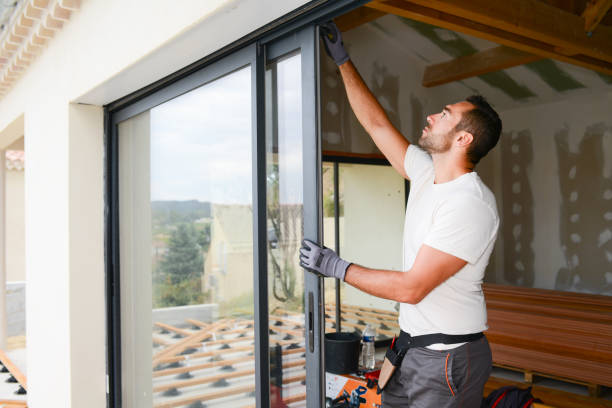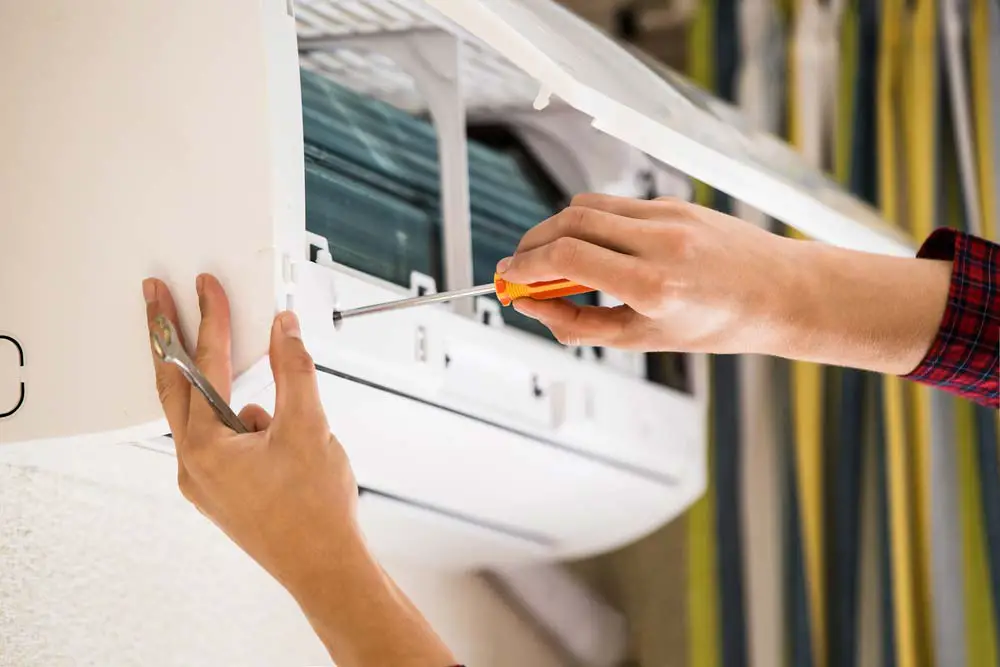Installing an air conditioner in a sliding window may seem like a daunting task, especially when you’re doing it for the first time. However, with the appropriate tools and a step-by-step guide, the process can be surprisingly straightforward and rewarding.
This guide aims to walk you through the process of how to install an air conditioner in a sliding window, ensuring that you stay cool even during the scorching summer heat.
We’ll provide you with a detailed installation procedure, including what you’ll need, potential challenges you may encounter, and how to overcome them.
Air conditioning is vital for maintaining comfort and optimal living conditions, particularly during the hot summer months. It helps to regulate indoor temperature, making the environment cooler and more comfortable.
Beyond comfort, air conditioning also improves air quality by filtering out pollutants and allergens, thus promoting better health. Specifically, a sliding window air conditioner offers several advantages. It’s generally more affordable and easier to install compared to central air conditioning systems.
Furthermore, it’s ideal for cooling single rooms or small spaces, and its compact design makes it a good option for apartments or houses with limited space.
With its power and convenience, a sliding window air conditioner can be a wise investment for those seeking to beat the summer heat.
Tools Required
Before you begin the installation process, it’s important to gather all the necessary tools. Here’s what you’ll need:
- Tape Measure: You’ll need a tape measure to accurately measure the dimensions of your window and the air conditioner unit. The unit must fit perfectly within the window frame to ensure optimal functioning and safety.
- Level: A level is used to ensure that the air conditioner is perfectly horizontal when installed. This is important as an uneven air conditioner can lead to improper operation or even water leakage.
- Screwdriver: A screwdriver will be used to secure the air conditioner and the mounting brackets in place. Both flat-head and Phillips-head screwdrivers may be needed depending on the types of screws included with your unit.
- Drill and Drill Bits: You might need drill and drill bits if you need to make additional holes in your window frame or wall to securely mount the unit.
- Weatherstripping material: Weatherstripping material is used to seal any gaps between the air conditioner and the window frame, preventing cool air from escaping and warm air from entering.
- Safety Gloves and Glasses: Safety gloves will protect your hands during the installation process, while safety glasses will protect your eyes from dust and debris.
Pre-Installation Steps
Measure the Window Dimensions

Before purchasing your sliding window air conditioner, you will need to accurately measure the dimensions of your window. This includes the width and the height of the window opening. Use your tape measure to obtain these measurements.
It’s crucial to measure from the inside edges of the window frame where the air conditioner will sit. Make sure to record these measurements as they will aid in choosing the right air conditioner for your window.
Choose the Right Air Conditioner for the Window Size
Once you have the window dimensions, you can start looking for an appropriate air conditioner unit. Air conditioners come in a variety of sizes, so it’s crucial to find one that matches your window’s measurements.
The unit should fit snugly within the window frame to ensure maximum efficiency and safety. Check the product specifications or consult with the store’s sales representative to confirm the dimensions of the air conditioner.
Also, consider the room size and the unit’s cooling capacity (measured in British Thermal Units or BTUs). A unit that is too small may not cool effectively, while one that is too large might cool too quickly without properly dehumidifying the room.
Installation Process
Step 1: Preparing the Window

The first step in the process of installing your air conditioner is preparing the window. Start by thoroughly cleaning the inside of the window and the window sill to remove any dust and debris.
Inspect the window for any damages such as cracks or gaps which could potentially allow cool air to escape and warm air to enter, affecting the efficiency of your air conditioner.
If any damages are detected, they should be repaired before proceeding with the installation. Next, open the window and remove the screen if one is present. This should provide you with an unobstructed area to install your air conditioner.
Step 2: Attaching the Brackets
The second step involves attaching the brackets that will hold your air conditioner in place. Most modern window units come with mounting brackets for secure installation.
Begin by attaching the brackets to the air conditioner unit, following the manufacturer’s instructions. Usually, these brackets fit onto the sides or the top of the air conditioner unit. Ensure that the screws are tightly fastened to prevent the air conditioner from slipping.
Once the brackets are attached to the unit, you can now place the air conditioner in the window opening. The brackets should rest securely against the window sill, while the unit should fit snugly within the window frame.
It’s essential to check that the unit is level in the window to facilitate proper drainage of condensation, an aspect critical for the long-term function of your air conditioner.
Step 3: Positioning the Air Conditioner

In this step, we’ll focus on correctly positioning the air conditioner in the sliding window. To start, gently lower your window onto the top of the unit. The unit should be tilted slightly to allow for proper drainage; refer to the manufacturer’s guidelines for the exact tilt degree.
Next, you’ll need to extend the accordion panels on either side of the air conditioner to cover the open areas of the window. These panels should fit snugly against the window frame to prevent air from escaping.
Always double-check to ensure that the air conditioner is securely in place and that there’s no risk of it falling out of the window. If everything is secure, you’ve successfully positioned your air conditioner.
Step 4: Securing the Air Conditioner
Now that the air conditioner is positioned properly, the next step involves securing it to ensure it remains firmly in place. Start by attaching the mounting brackets to your window frame, ensuring they’re tightly fastened.
These brackets should hold your air conditioner unit securely, reducing the risk of it falling out. It is highly recommended to use additional security measures, such as foam seal strips around the perimeter of the window and unit.
These strips will ensure a snug fit, prevent air leakage, and deter pests. Finally, lock your window into place. This final step is crucial, as it prevents the window from being accidentally raised, which could dislodge the air conditioner.
After accomplishing this step, your air conditioner should be securely installed in your sliding window.
Related Topics:
Post-Installation Steps
After ensuring the air conditioner is securely installed, the final step is to test the unit to guarantee its proper functioning. Plug the unit into an appropriate electrical outlet and switch it on. Run through all the different settings, making sure that the cooling, fan speed, and temperature controls work as expected.
Listen for any unusual noises, as these could indicate a problem. Also, check that the airflow is consistent and strong. If your air conditioner has a programmable thermostat, now is a good time to set your preferred temperature.
Remember, it may take a few minutes for the air conditioner to cool down to your set point. If everything operates as expected, congratulations, your air conditioner is now ready for use.
If you experience any issues, refer to the troubleshooting section of your user manual, or contact the manufacturer’s customer service.
Safety Tips
When you’re dealing with an air conditioning unit, safety should always be a top priority. Because these units are heavy and can be complex to install, it’s crucial to take some safety precautions.
Always read and adhere to the manufacturer’s instructions. This is not only important for the successful operation of your air conditioner but also ensures your safety during the installation process.
Never handle an air conditioner or its components with wet hands as it increases the risk of electric shock. When lifting and positioning the unit, be careful not to strain your back; seek help if it is too heavy to handle alone. Always make sure your ladder or step stool is sturdy and positioned on a flat surface.
Moreover, when installing an air conditioner in a sliding window, ensure the window is securely locked after installation to prevent any accidental fall of the unit.
Routinely check and maintain the unit as per the manufacturer’s guidelines to ensure its efficient and safe operation. Remember, safety first!
Conclusion
In conclusion, installing an air conditioner in a sliding window might initially seem overwhelming, but with the right planning, equipment, and safety precautions, it’s an achievable task.
This guide has equipped you with the necessary steps to carry out the installation process successfully, from gathering the required tools to testing the unit after installation.
By taking the time to ensure your air conditioner is correctly installed and safely secured, you’re investing in a cooler, more pleasant environment during those hot summer months.
Remember, safety is paramount at every step, and don’t hesitate to seek professional help if the task seems too complicated. Enjoy the fresh, cool air and the satisfaction of a job well done!
FAQs
What type of air conditioner is suitable for a sliding window?
Generally, a vertical or casement window air conditioner is suitable for a sliding window. These air conditioners are specifically designed to fit into sliding window tracks. They are taller and narrower compared to regular window units, allowing them to fit in the sliding window’s unique design.
Can I install an air conditioner in a sliding window without a professional’s help?
Yes, with careful preparation and the right tools, you can install an air conditioner in a sliding window by yourself. However, if the unit is heavy or you’re not comfortable with the process, it’s highly recommended to seek professional help to ensure safe and efficient installation.

1 thought on “How To Install An Air Conditioner In A Sliding Window”